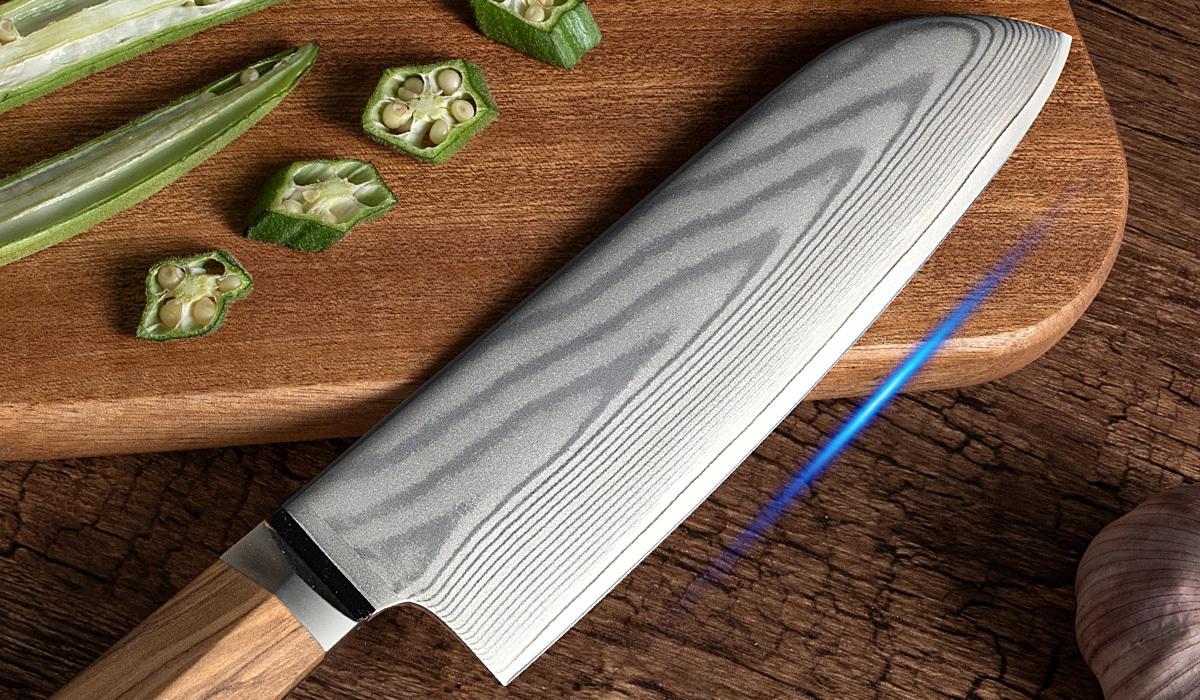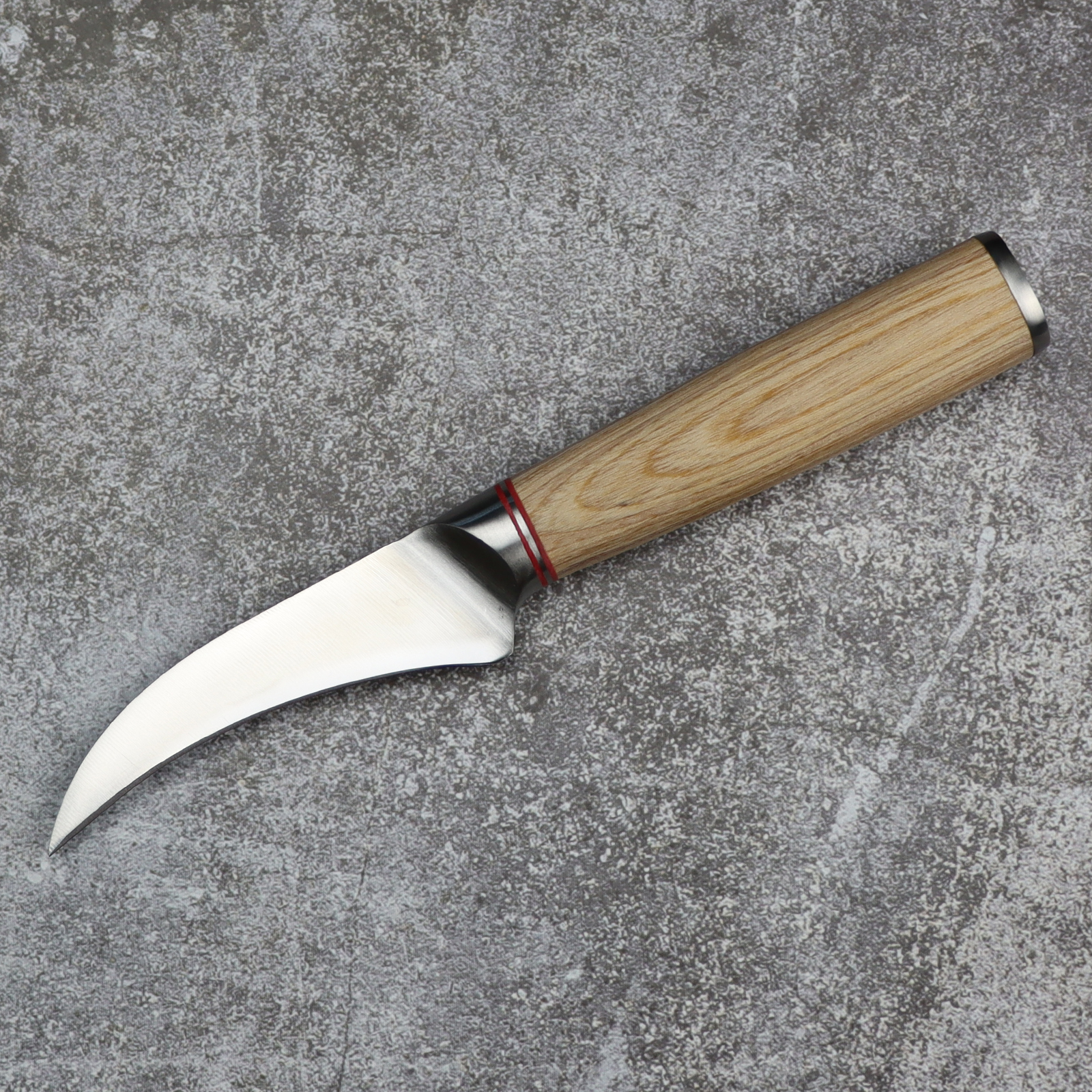The Complete Guide to Santoku Knives
Aug 23,2023 | Fzkaly
From the bustling kitchens of Tokyo to the Michelin-starred restaurants of New York, Santoku knives have established themselves as a must-have tool for discerning chefs. Their versatility, razor-sharp blades, and ergonomic designs have made them the go-to choice for professionals seeking precision and efficiency in their culinary endeavors. In fact, the popularity of Santoku knives has transcended cultural boundaries, becoming a symbol of culinary excellence around the globe. In this article, we delve into the fascinating world of Santoku knives, exploring their unique features and the innovations that make them indispensable in the modern kitchen.

First, let's discuss the innovative technologies of Santoku knives.
Innovative Material Selection
Santoku knives integrate advanced materials chosen for their exceptional properties. High-carbon stainless steel is commonly used for its superior hardness, corrosion resistance, and edge retention capabilities. This material ensures that the blade maintains its sharpness and durability, even with frequent use. Additionally, the blade's composition may include alloys or laminated constructions, further enhancing its strength and longevity.
Blade Craftsmanship
Santoku knives exemplify precision blade craftsmanship, combining traditional techniques with modern innovations. The blades undergo a meticulous heat treatment process, including tempering, to achieve optimal hardness, flexibility, and edge retention. This results in blades that are exceptionally sharp, durable, and resistant to wear and tear. The thin blade profile allows for precise slicing, dicing, and mincing, making Santoku knives ideal for a wide range of culinary tasks.
Ergonomic Handle Design
Santoku knives feature ergonomic handle designs that prioritize user comfort and control. Handle materials, such as high-quality hardwoods or synthetic composites, are carefully selected for their durability and resistance to moisture. The handles are shaped to fit comfortably in the hand, providing a secure grip and reducing hand fatigue during extended use. The balance between the blade and handle ensures optimal control, facilitating precise cutting motions.
Aesthetic Appeal
Santoku knives embrace both functionality and aesthetics, incorporating visually appealing design elements. The blade may feature unique patterns, such as Damascus or hammered finishes, adding a touch of elegance to the knife's appearance. The handles often showcase elegant curves, textured surfaces, or intricate detailing, enhancing the overall visual appeal. Santoku knives are not only exceptional tools but also pieces of functional art that elevate the culinary experience.
Practical Advantages
The innovative technologies employed in Santoku knives provide numerous practical advantages for both professional chefs and home cooks. The combination of superior materials, precise blade craftsmanship, and ergonomic handle design results in knives that excel in performance, precision, and durability. The versatility of Santoku knives allows for seamless transitioning between various cutting techniques, from slicing and dicing to chopping and mincing. Their sharpness and edge retention minimize the need for frequent sharpening, ensuring long-lasting usability and convenience.
Next, Let's move on to the unique features and design elements of the Santoku knife compared with a chef knife.
Versatility in Cutting Techniques
One of the standout features of Santoku knives is their versatility in handling different cutting techniques. While the chef knife is primarily designed for rocking and chopping motions, Santoku knives excel in slicing, dicing, and mincing due to their straighter edge and shorter, broader blade. The flat blade profile allows for precise downward cuts, making Santoku knives particularly well-suited for tasks like paper-thin slicing of vegetables or delicate ingredients.
Hollow Edge for Reduced Food Adhesion
Many Santoku knives incorporate a granton edge, which features shallow, scalloped indentations along the blade's side. This unique design minimizes the surface area in contact with food, reducing the likelihood of ingredients sticking to the blade. The Granton edge is especially advantageous when cutting thinly sliced or sticky foods like cheese, potatoes, or sushi rolls, enhancing efficiency and preventing ingredients from clinging to the blade.
Balanced and Nimble Handling
Santoku knives are renowned for their well-balanced construction, allowing for effortless maneuverability and precise control. With a shorter and wider blade compared to a chef knife, Santoku knives distribute the weight evenly between the blade and handle, resulting in a harmonious balance. This balance, combined with the ergonomic handle design, provides users with enhanced stability, agility, and comfort during extended use.
Japanese Design Influence
Santoku knives trace their origins to Japan and bear the influence of traditional Japanese knife-making techniques. This influence is evident in their aesthetic appeal and meticulous craftsmanship. The blade may showcase unique patterns such as Damascus or hammered finishes, reflecting the artistry and attention to detail. The Japanese influence extends to the ergonomic handle design, incorporating graceful curves and ergonomic contours that conform comfortably to the hand.
All-Purpose Knife for Everyday Use
While chef knives are renowned for their versatility, Santoku knives offer a more compact and agile alternative suitable for everyday cooking. Their combination of slicing, dicing, and mincing capabilities makes them a go-to choice for a wide range of kitchen tasks. Whether you're preparing vegetables, meat, or fish, the Santoku knife's design ensures optimal performance and precision.
As we conclude our exploration of the unique features of Santoku knives, let's now transition to our recommended brands that embody the essence of these exceptional culinary tools.
Santoku Recommendations
1. Japanese Damascus Santoku Knife 7"
A genuine Japanese Damascus Santoku knife with a hexagonal olive wood handle that feels incredibly comfortable to hold.
_1728x.jpeg?w=1600&h=1600)
This knife is a true work of art, crafted with the highest standards of craftsmanship. Its unique pattern, forged with precision, rivals that of renowned brands.
Effortlessly slice, dice, and chop your way through ingredients with this top-notch Santoku knife. Its razor-sharp blade and well-balanced design ensure precise cuts every time. Whether you're a professional chef or a home cooking enthusiast, this knife will definitely elevate your culinary experience.
2. Fzkaly Classic 7" Santoku Knife
This high-carbon steel Santoku knife is made with German X50CrMov15 stainless steel. featuring a comfortable rosewood handle with three sturdy rivets. The handle provides a secure grip and a delightful feel in your hand.

With its classic design and hollow edge, this Santoku knife combines elegance with functionality. The well-balanced weight distribution ensures precision and control during your cutting tasks.
What's more, the price is affordable.
3. 7" Japanese Damascus Santoku Knife
The handle of this Japanese chef knife is a visual delight, combining a 3D-designed ebony wood handle with vibrant green resin, accented by a stylish red G10 ring and an elegant copper flower nail. Not only does it look stunning, but its ergonomic curve ensures a comfortable and secure grip during use.
Now, let's talk about the blade. This VG10 Damascus Santoku knife features a hand-sharpened 12°-15° bevel edge, guaranteeing exceptional sharpness and precision with each and every cut.
Conclusion
Santoku knives differentiate themselves from other knives, such as the chef knife, through their unique features and design elements. With their versatile cutting capabilities, a hollow edge for reduced food adhesion, balanced handling, and Japanese-influenced craftsmanship, Santoku knives have earned their place in the culinary world. Whether you're a professional chef or a passionate home cook, the Santoku knife's distinct qualities and functional advantages make it a valuable addition to your kitchen arsenal, enabling you to achieve precision, efficiency, and culinary excellence.

_1080x.jpeg?w=1000&h=1000)


